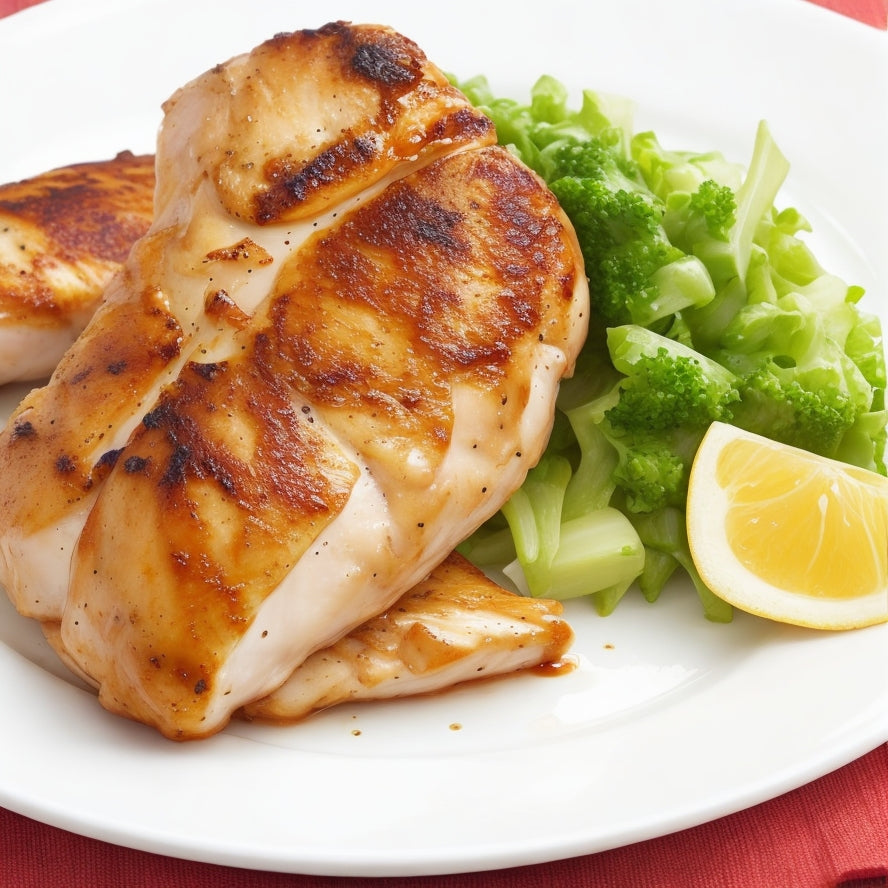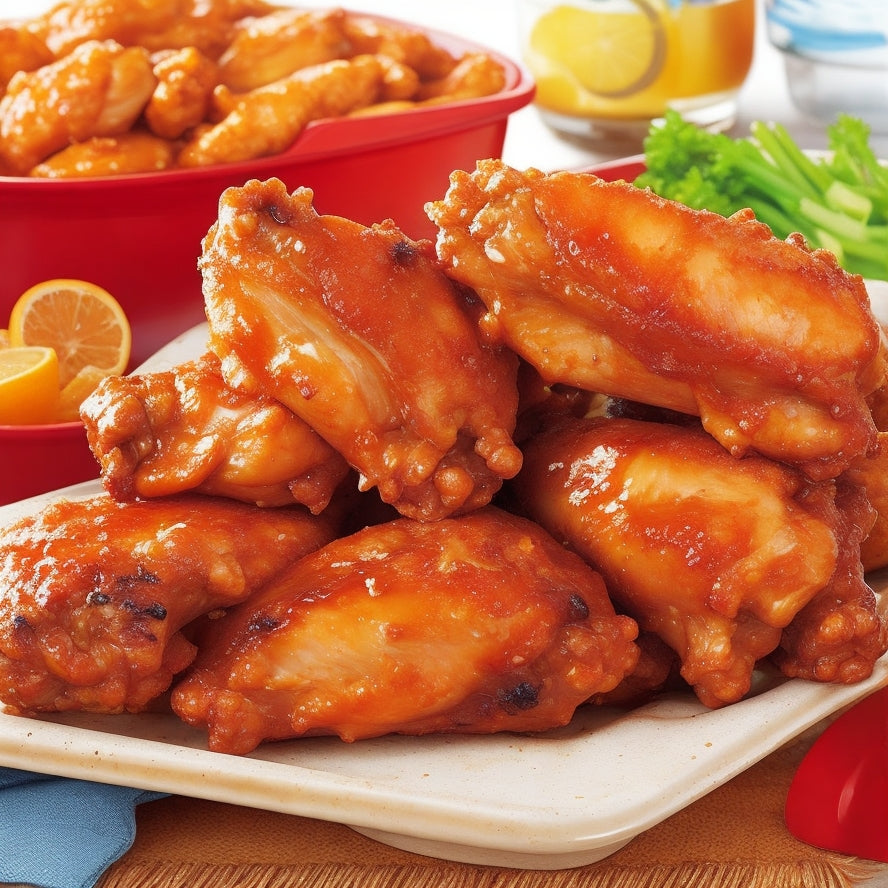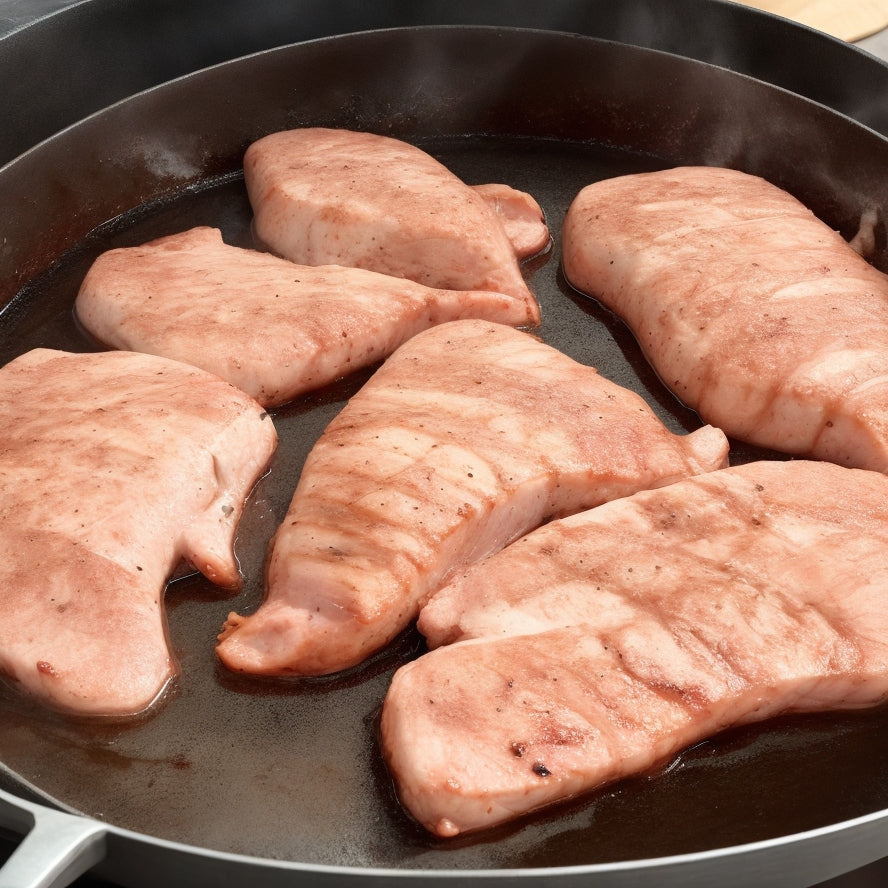Chicken breast: 289 calories
One serving of skinless, boneless, cooked chicken breast (174 g) has the following nutritional facts [1]:
- Calories: 289
- Protein: 55.9 grams
- Carbohydrates: 0 g
- Fat: 5.64g
A 3.5-ounce (100-gram) serving of chicken breast provides 166 calories, 32.1 grams of protein, and 3.24 grams of fat.
This means that approximately 80% of the calories in chicken breast come from protein and 20% from fat.
The nutritional values mentioned pertain to the unadulterated form of chicken breasts, untouched by additional ingredients or culinary embellishments. However, the moment one ventures into the realm of cooking with oils, marinating in flavorful concoctions, or adorning the poultry with savory sauces, the caloric, carbohydrate, and fat content undergo a transformative escalation, potentially altering the dietary profile of the dish.

Chicken thighs: 108 calories
One medium skinless, boneless, cooked chicken thighs (52 g) contains [2]:
- Calories: 108
- Protein: 13.4 grams
- Carbohydrates: 0 g
- Fat: 5.6 grams
A 3.5-ounce (100-gram) serving of chicken thighs provides 207 calories, 25.7 grams of protein, and 10.8 grams of fat.
So, 51% of calories come from protein and 49% from fat.

Chicken wings: 40 calories
While chicken wings may not immediately spring to mind as a paragon of dietary virtue, these oft-overlooked morsels can, in fact, seamlessly integrate into a balanced and wholesome regimen. Provided they are devoid of breading, sauces, or the indulgence of deep-frying, chicken wings can shed their indulgent reputation and emerge as a lean and nutrient-dense culinary delight, worthy of gracing even the most discerning of health-conscious plates.
One medium skinless and boneless chicken wing (21 g) contains [3]:
- Calories: 40
- Protein: 6 grams
- Carbohydrates: 0 g
- Fat: 1.6 grams
Per 3.5 ounces (100 grams), chicken wings provide 201 calories, 30.2 grams of protein, and 8.1 grams of fat.
This means 62% of the calories come from protein and 38% from fat.

Chicken drumstick: 72 calories
One medium skinless and boneless chicken drumstick contains [4]:
- Calories: 72
- Protein: 11.8 grams
- Carbohydrates: 0 g
- Fat: 2.4 grams
Chicken drumstick contain 171 calories, 28.1 grams of protein, and 5.6 grams of fat per 3.5 oz (100 g) serving.
When it comes to calorie count, approximately 69% comes from protein and 31% comes from fat.
Other cuts of chicken
Here are the calories for some other chicken parts:
- Chicken Tenderloins:98 calories per 3.5 oz (100 g) [5]
- Chicken Back:298 calories per 3.5 oz (100 g) [6]
- Chicken livers:167 calories per 3.5 oz (100 g) [7]
- Chicken Gibles:239 calories per 3.5 oz (100 g) [8]
Chicken skin adds calories
A medium boneless, skin-on cooked chicken breast contains [9]:
- Calories: 382
- Protein: 57.9 grams
- Fat: 15.1g
In skin-on chicken breast, 63% of calories come from protein and 37% come from fat. In addition, eating the skin will increase calories.
Similarly, a medium skin-on chicken wing contains 92 calories, while a medium skinless chicken wing contains 40 calories. Therefore, 62% of calories in skin-on wings come from fat [10], compared to 38% in skinless wings.
For those who want to lose weight or reduce their fat intake, it's wise to savor the tender, delicious taste of chicken without the crispy skin. By choosing chicken with the skin removed, you can seriously reduce your caloric intake and fat absorption.
How to cook chicken is important
But skinless chicken drumsticks, also fried in batter, contain 113 calories and 5.4 grams of fat. Fried chicken drumsticks with skin even contain 162 calories and 9.3 grams of fat [11].
Therefore, cooking methods that add small amounts of fat, such as poaching, roasting, grilling, and steaming, are the best options for keeping calorie counts low.

Summary
Reference article
[1] FoodData Central. (n.d.-b). https://fdc.nal.usda.gov/fdc-app.html#/food-details/331960/nutrients
[2] FatSecret. (n.d.-b). Calories in 1 medium Chicken Thigh (Skin Not Eaten) and Nutrition Facts. https://www.fatsecret.com/calories-nutrition/generic/chicken-thigh-skin-not-eaten?portionid=6404&portionamount=1.000
[3] FatSecret. (n.d.-c). FatSecret. (n.d.-d). Calories in 1 medium Chicken Wing (Skin Not Eaten) and Nutrition Facts. https://www.fatsecret.com/calories-nutrition/generic/chicken-wing-skin-not-eaten?portionid=5827&portionamount=1.000
[4] FatSecret. (n.d.-a). Calories in 1 medium Chicken Drumstick (Skin Not Eaten) and Nutrition Facts. https://www.fatsecret.com/calories-nutrition/generic/chicken-drumstick-skin-not-eaten?portionid=4955&portionamount=1.000
[5] FoodData Central. (n.d.-c). https://fdc.nal.usda.gov/fdc-app.html#/food-details/887454/nutrients
[6] FatSecret. (n.d.-e). Calories in 100 g of Chicken Back and Nutrition Facts. https://www.fatsecret.com/calories-nutrition/generic/chicken-back?portionid=50408&portionamount=100.000
[7] FatSecret. (n.d.-g). Calories in chicken liver (Simmered, Cooked) and nutrition facts. https://www.fatsecret.com/calories-nutrition/usda/chicken-liver-(simmered-cooked)
[8] FatSecret. (n.d.-g). Calories in chicken giblets (Roasting, simmered, cooked) and nutrition facts. https://www.fatsecret.com/calories-nutrition/usda/chicken-giblets-(roasting-simmered-cooked)
[9] FatSecret. (n.d.-e). Calories in 1/2 medium Chicken Breast and Nutrition Facts. https://www.fatsecret.com/calories-nutrition/generic/chicken-breast-ns-as-to-skin-eaten?portionid=5035&portionamount=0.500
[10] FatSecret. (n.d.-d). Calories in 1 medium Chicken Wing (Skin Eaten) and Nutrition Facts. https://www.fatsecret.com/calories-nutrition/generic/chicken-wing-skin-eaten?portionid=5269&portionamount=1.000
[11] FatSecret. (n.d.-g). Calories in 1 thigh, bone removed of Chicken Thigh Meat and Skin (Broilers or Fryers, Flour, Fried, Cooked) and Nutrition Facts. https://www.fatsecret.com/calories-nutrition/usda/chicken-thigh-meat-and-skin-(broilers-or-fryers-flour-fried-cooked)?portionid=31041&portionamount=1.000














